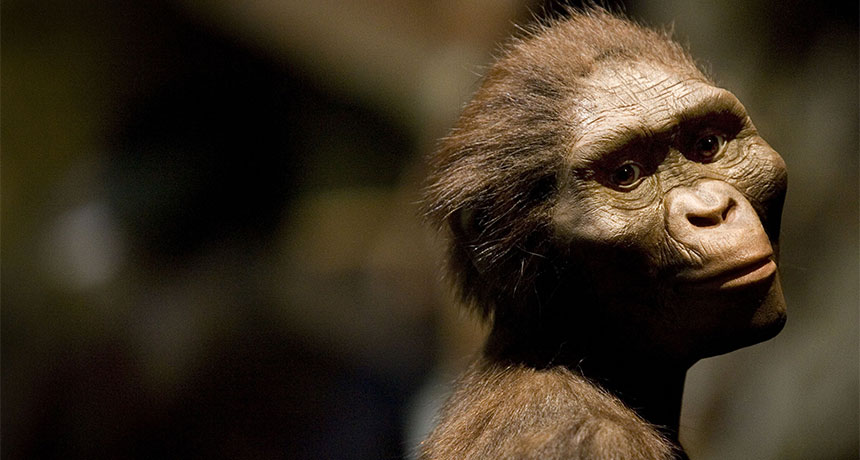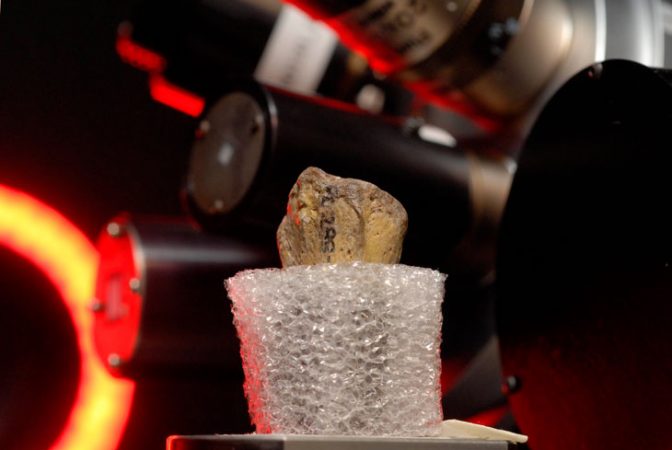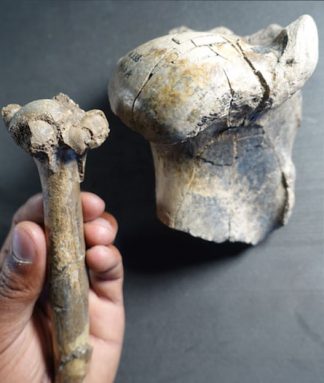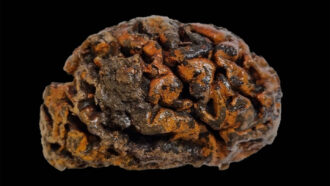‘Cousin’ Lucy may have fallen from a tree to her death 3.2 million years ago
Disputed fossil autopsy says this early hominid broke many bones

Lucy is the name given to a 3.2-million-year-old partial skeleton of an Australopithecus afarensis. Scientists say that its damaged bones suggest the ancient hominid plummeted to her death from high in a tree. Not everyone accepts that.
DAVE EINSEL/GETTY IMAGES
By Bruce Bower
A fossil named “Lucy” may be the most famous member of the human family tree. Scientists working in Ethiopia found her fossil bones in 1974 . Those researchers named her Lucy after a Beatles song — “Lucy in the Sky with Diamonds.” Now, a controversial study claims Lucy may have met a sad end. It argues that she appears to have tumbled to her death from high up in a tree.
Lucy lived some 3.2 million years ago. She belonged to the species Australopithecus afarensis (Aw-STRAAL-oh-PITH-eh-kus AFF-ur-EN-sis). It’s a hominid, meaning she came from a family that includes humans and our most recent ancient relatives. Some damage to Lucy’s partial skeleton most likely occurred when she fell from a tree, researchers now say. She may have fallen, while climbing or sleeping, from a height of 13 meters (43 feet) or more.
Lucy had bone breaks from head to ankle. Her right shoulder blade slammed into the top of her upper arm bone. The shoulder end of her arm bone displays sharp breaks. Bone fragments and slivers had been forcibly driven into the bone’s shaft. All of these breaks fit a scenario in which Lucy fell as far as from the top of a four to five story building. The breaks would have occurred if she landed feet first before thrusting her arms out in an attempt to break her fall, says John Kappelman. He is a paleoanthropologist at the University of Texas at Austin. He led the new study, whichwas published online August 29 in Nature.

Such damage often shows up in people today who fall from great heights or are in serious car accidents, he notes. Massive internal bleeding typically follows a body slam as hard as Lucy’s, he says. Indeed, he adds, “Lucy probably bled out pretty fast after falling.”
Nonsense, responds Tim White. He is a paleoanthropologist at the University of California, Berkeley. The new paper is an example of scientific storytelling, he charges. It is “being used as clickbait for a commercial journal eager for media coverage.”
The cracks and breaks throughout Lucy’s skeleton occurred after her death, White asserts. Bone cracking was caused by fossilization, he says. Pressure on fossils embedded in eroding sandstone also can cause such cracks. Breaks much like Lucy’s, and due to fossil-forming, can be seen in the bones of many nonclimbing animals. These include gazelles, hippos and rhinos, White notes. Those bones show extensive shoulder-joint damage similar to Lucy’s, he says.
Doctors have documented frequent bone breaks when people accidentally fall from heights between two and 21 meters (seven and 69 feet), White adds. Such breaks have been found in the spine, head, elbows, wrists, ankles and feet. But they have not been found in the shoulders.
Donald Johanson is now an anthropologist at Arizona State University in Tempe. Back in 1974 he led the team that found Lucy. He was joined at the time by his then-graduate student Tom Gray. Since her discovery, scientists have been unable to figure out how Lucy died. In 1982, a Johanson-led team, which included White, attributed Lucy’s bone damage mostly to fossilization.

Kappelman, though, was intrigued by extensive crushing and breakage at Lucy’s right shoulder joint. He consulted Stephen Pearce. Pearce is an orthopedic surgeon at the Austin Bone and Joint Clinic in Texas. Pearce was shown a 3-D printed model of Lucy’s skeleton. It was enlarged to the size of a modern human adult. (Lucy stood only about 107 centimeters tall, or 3 feet, 6 inches.) Pearce thought the arm damage looked like that caused by extending an arm to break a steep fall.
Kappelman and his colleagues then scoured high-resolution CT scans of Lucy’s bones. They had been taken in 2008. That was when the ancient skeleton was brought from Ethiopia to the University of Texas during a U.S. museum tour.
Damage consistent with hitting the ground after a long fall also appeared in bones from an ankle, legs, pelvis, lower back, ribs, jaw and braincase, the researchers say. Fossilization and the forces of geology caused additional cracking and breaks in Lucy’s remains, they add. A report had described these back in 1982.
William Jungers was initially skeptical that a cause of death could be discerned in a fossil hominid as old as Lucy. He is a paleoanthropologist at the Stony Brook University Medical Center in New York. But the evidence indeed points to a fatal fall, he now argues. No other explanation can account for Lucy’s pattern of bone damage, he says.
If Lucy toppled out of a tree while climbing or snoozing in a nest, her kind must have split time between life on the ground and in trees, Kappelman says. Some researchers have long argued that A. afarensis was built mainly for walking, rather than tree climbing.
Even today, Jungers says, human deaths from accidental falls out of trees occur among some African hunter-gatherers. That especially occurs when they may be raiding bees’ nests for honey. It also occurs in wild chimpanzees. And these are animals more adept at tree climbing than Lucy was.
Lucy’s species could climb trees, White says. But, he notes, “we do not know how often, or whether for shelter or food.”







